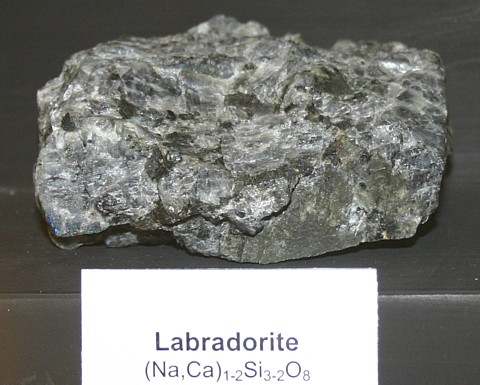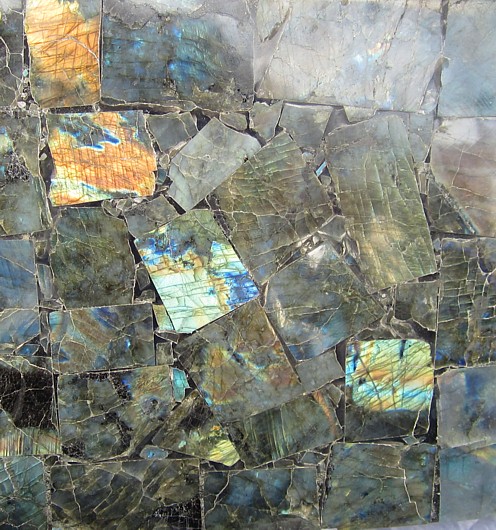|
.
Labradorite Mineral Facts:
Chemical Formula:
1NaAlSi308
to
3CaAl2Si208
Intermediate between albite and
anorthite corresponding chiefly to one quarter albite and three quarters
anorthite.
Colors:
Grey, brown, green, reddish, rarely colorless.
Streak
nearly colorless. Sometimes shows a rich play of iridescent colors,
blue, gold and green generally predominating. This play of color is not
always seen.
Hardness:
6
Density: 2.73
Cleavage:
The usual
feldspar cleavage; perfect parallel to basal plane, less perfect
parallel to brachypinacoid.
Crystallography: Triclinic
Well formed
crystals are uncommon; when crystals are found they are usually in thin
tabular crystals flattened parallel to the brachypinacoid. The angle
between basal plane and the brachypinacoid is a little more than
86 degrees. Labradorite usually occurs in cleavable crystalline masses.
Luster:.
Vitreous luster that is
nearly pearly on
the cleavage planes. It is transparent to opaque.
|

Labradorite Feldspar |
|
Composition,
Structure and Associated Minerals:
Labradorite,
bytownite and anorthite are commonly found in the more basic igneous rocks.
The most brilliantly colored plagioclases are some forms of labradorite,
which, on cleavage surfaces, show a great display of yellow, green, red,
purple and blue flashes in reflected light. The cause of the play of colors
is not exactly known, but it is probably due twinning planes and the
presence of numerous very tiny parallel acicular inclusions.
The
twins in Labradorite are like those of albite, but the twins are usually in
broad lamellae as opposed to the finer lamellae of albite. In weathering it
alters to
epidote, and in some
instances into scapolite, and very commonly into the mixture known as
saussurite, which is an aggregate containing
zoisite or
garnet as
its most important component.
Identification
and Diagnostics
Before the blowpipe it fuses
rather more easily than orthoclase or oligoclase to a colorless glass.
Powdered labradorite is soluble in hot hydrochloric acid. To be told from
albite only by a test for calcium. Briefly, the test is made as follows:
Fuse powdered mineral with sodium carbonate; dissolve fusion in hydrochloric
acid and evaporate to dryness, moisten residue with water and a little
nitric acid, boil and then filter off insoluble silica; to filtrate add
ammonium hydroxide in excess, filter off precipitate of aluminum hydroxide;
in filtrate get precipitate of calcium oxalate upon addition of ammonium
oxalate. To be positively distinguished from andesine and oligoclase only by
a chemical analysis or an optical examination.
|

Decorative Labradorite Feldspar with play
of color |
|
|
Occurrence,
Localities and Origins:
Occurs as a primary constituent
of basic igneous rocks gabbro, dolerite, and basalt.
Its occurrence is like albite,
but more commonly in the darker colored basic igneous rocks, and usually
associated with pyroxene or amphibole. Found on the coast of Labrador in
large amounts, associated with hypersthene and
magnetite, and when
polished showing a fine iridescent play of colors. This
beautiful play of colors is due
in part to the intimate twinning structure, and in part to inclusions.
Labradorite crystals occur
at Visegrad, Hungary; and at Mt. Aetna, Italy; and beautiful cleavage pieces
come from Labrador, where it forms one of the constituents of a
coarse-grained igneous rock.
Uses:
Used as an
ornamental stone and to a limited extent as a gemstone.
Labradorite and
andesine-labradorite often show a peculiar sheen or "schillerization" due to
microscopic linear inclusions which show a parallel arrangement. Feldspar of
this kind was first found in the coarse gabbros of Labrador, hence the name.
Similar material occurs also in Russia and in the United States and is
sometimes used as a gemstone. It can be obtained in large pieces at and near
Nam, a Moravian mission station on the coast of Labrador, and these yield
slabs showing a fine play of colors when suitably cut and polished. In spite
of its beauty, its ready cleavage and brittleness mitigate against its use
in a large way as an ordinary gemstone.
It is used as a decorative stone material.
Return to the
Mineral Collectors Information Page
|


